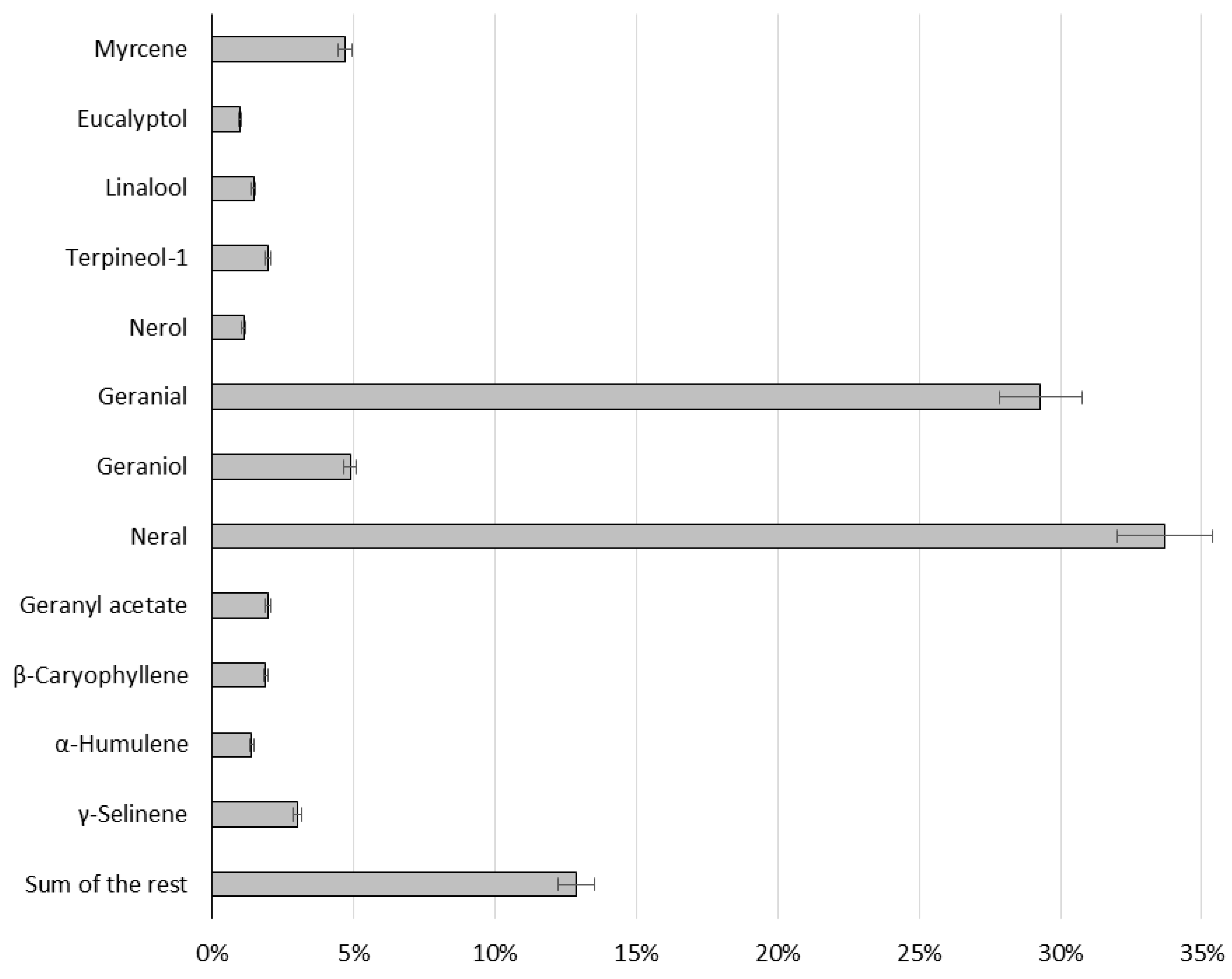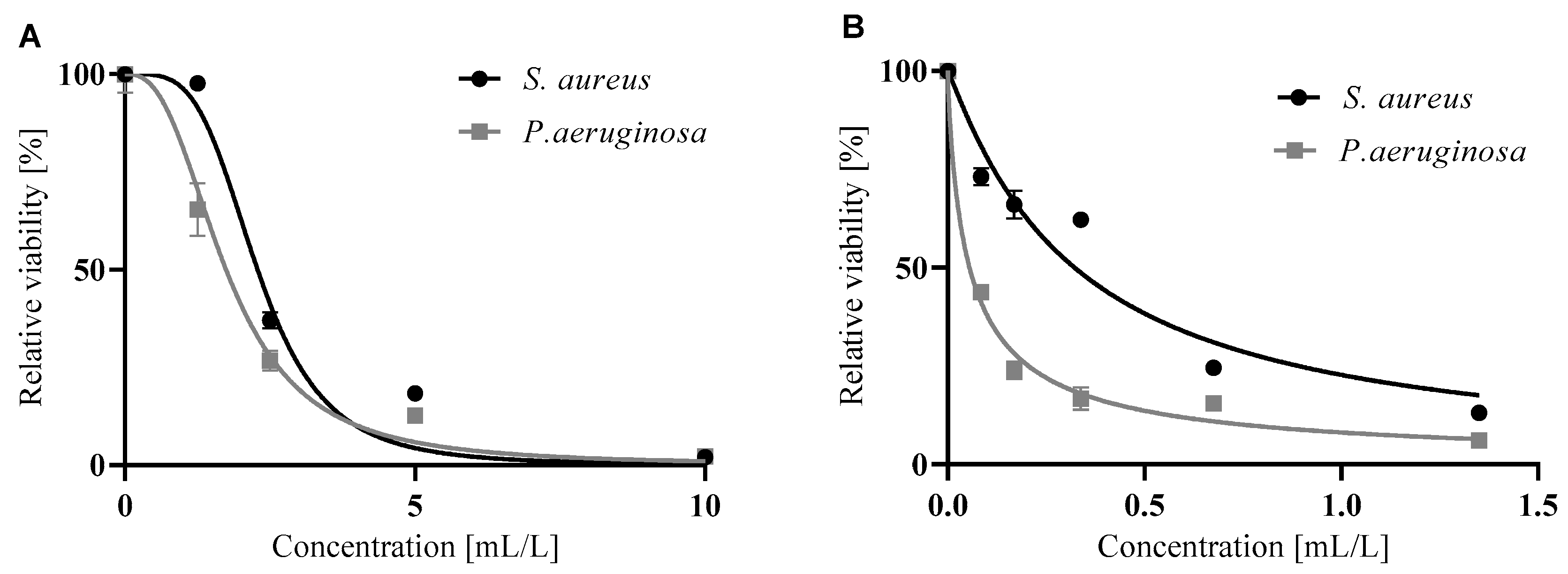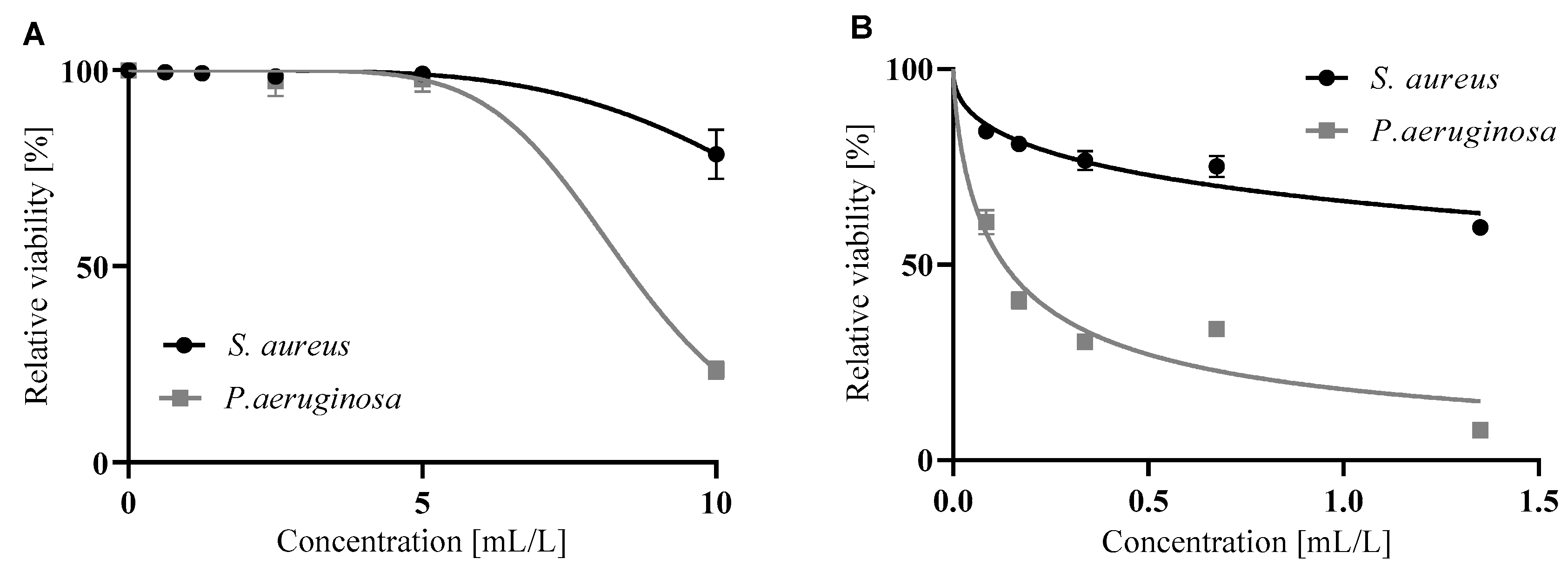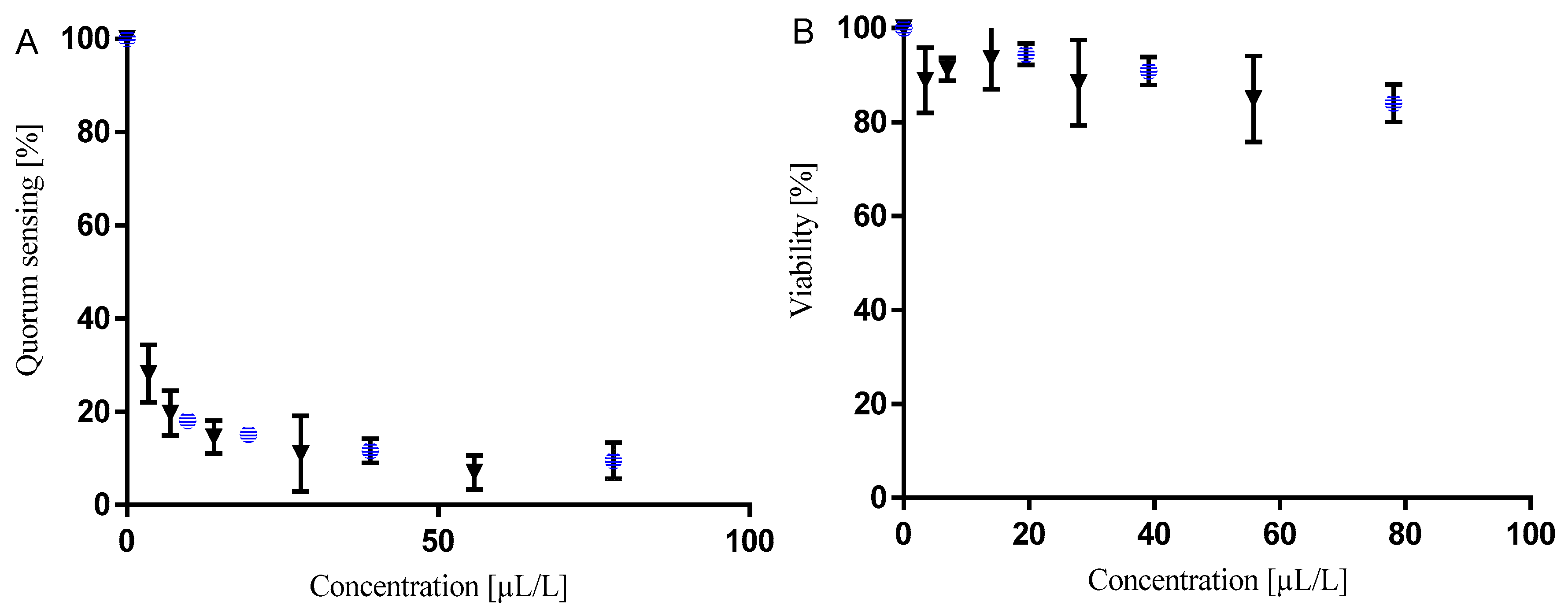Lemon Grass Essential Oil does not Modulate Cancer Cells Multidrug Resistance by Citral—Its Dominant and Strongly Antimicrobial Compound
Abstract
1. Introduction
2. Materials and Methods
2.1. Chemicals
2.2. Plant Material and Essential Oil Extraction
2.3. Essential Oil Composition Screening
2.3.1. Sample Preparation
2.3.2. GC-HRMS
2.4. Antimicrobial Activity
2.5. Anti-Biofilm Activity
2.6. Anti-Quorum Sensing Activity
2.7. Inhibition of Transmembrane Efflux Pump
2.8. Sensitization of Doxorubicin-Resistant Human Ovarian Carcinoma
2.9. Data Processing and Statistical Analysis
3. Results
3.1. Essential Oil Composition Screening
3.2. Antimicrobial Activity
3.3. Anti-Biofilm Activity
3.4. Inhibition of Bacterial Cell-To-Cell Communication
3.5. Modulation of MDR in Cancer Cells
4. Discussion
5. Conclusions
Author Contributions
Funding
Acknowledgments
Conflicts of Interest
References
- Ekpenyong, C.E.; Akpan, E.E. Use of Cymbopogon citratus essential oil in food preservation: Recent advances and future perspectives. Crit. Rev. Food Sci. Nutr. 2017, 57, 2541–2559. [Google Scholar] [CrossRef] [PubMed]
- Ekpenyong, C.E.; Akpan, E.; Nyoh, A. Ethnopharmacology, phytochemistry, and biological activities of Cymbopogon citratus (dc.) stapf extracts. Chin. J. Nat. Med. 2015, 13, 321–337. [Google Scholar] [CrossRef]
- Ganjewala, D. Cymbopogon essential oils: Chemical compositions and bioactivities. Int. J. Essent. Oil Ther. 2009, 3, 56–65. [Google Scholar]
- Avoseh, O.; Oyedeji, O.; Rungqu, P.; Nkeh-Chungag, B.; Oyedeji, A. Cymbopogon species; ethnopharmacology, phytochemistry and the pharmacological importance. Molecules 2015, 20, 7438–7453. [Google Scholar] [CrossRef] [PubMed]
- Bieski, I.G.; Leonti, M.; Arnason, J.T.; Ferrier, J.; Rapinski, M.; Violante, I.M.; Balogun, S.O.; Pereira, J.F.; Figueiredo Rde, C.; Lopes, C.R.; et al. Ethnobotanical study of medicinal plants by population of valley of juruena region, legal amazon, mato grosso, brazil. J. Ethnopharmacol. 2015, 173, 383–423. [Google Scholar] [CrossRef] [PubMed]
- De Santana, B.F.; Voeks, R.A.; Funch, L.S. Ethnomedicinal survey of a maroon community in brazil’s atlantic tropical forest. J. Ethnopharmacol. 2016, 181, 37–49. [Google Scholar] [CrossRef]
- Fongnzossie, E.F.; Tize, Z.; Fogang Nde, P.J.; Nyangono Biyegue, C.F.; Bouelet Ntsama, I.S.; Dibong, S.D.; Nkongmeneck, B.A. Ethnobotany and pharmacognostic perspective of plant species used as traditional cosmetics and cosmeceuticals among the gbaya ethnic group in eastern cameroon. S. Afr. J. Bot. 2017, 112, 29–39. [Google Scholar] [CrossRef]
- Ochwang’i, D.O.; Kimwele, C.N.; Oduma, J.A.; Gathumbi, P.K.; Mbaria, J.M.; Kiama, S.G. Medicinal plants used in treatment and management of cancer in kakamega county, kenya. J. Ethnopharmacol. 2014, 151, 1040–1055. [Google Scholar] [CrossRef]
- Rehecho, S.; Uriarte-Pueyo, I.; Calvo, J.; Vivas, L.A.; Calvo, M.I. Ethnopharmacological survey of medicinal plants in nor-yauyos, a part of the landscape reserve nor-yauyos-cochas, peru. J. Ethnopharmacol. 2011, 133, 75–85. [Google Scholar] [CrossRef]
- Shi, C.; Sun, Y.; Liu, Z.; Guo, D.; Sun, H.; Sun, Z.; Chen, S.; Zhang, W.; Wen, Q.; Peng, X.; et al. Inhibition of Cronobacter sakazakii virulence factors by citral. Sci. Rep. 2017, 7, 43243. [Google Scholar] [CrossRef]
- Souza, P.M.; Goulart, F.R.V.; Marques, J.M.; Bizzo, H.R.; Blank, A.F.; Groposo, C.; Sousa, M.P.; Volaro, V.; Alviano, C.S.; Moreno, D.S.A.; et al. Growth inhibition of sulfate-reducing bacteria in produced water from the petroleum industry using essential oils. Molecules 2017, 22, 648. [Google Scholar] [CrossRef] [PubMed]
- Korenblum, E.; Regina de Vasconcelos Goulart, F.; de Almeida Rodrigues, I.; Abreu, F.; Lins, U.; Alves, P.B.; Blank, A.F.; Valoni, E.; Sebastian, G.V.; Alviano, D.S.; et al. Antimicrobial action and anti-corrosion effect against sulfate reducing bacteria by lemongrass (Cymbopogon citratus) essential oil and its major component, the citral. AMB Express 2013, 3, 1–8. [Google Scholar] [CrossRef] [PubMed]
- Madeira, P.L.B.; Carvalho, L.T.; Paschoal, M.A.B.; de Sousa, E.M.; Moffa, E.B.; da Silva, M.A.D.S.; Tavarez, R.D.J.R.; Gonçalves, L.M. In vitro effects of lemongrass extract on Candida albicans biofilms, human cells viability, and denture surface. Front. Cell. Infect. Microbiol. 2016, 6, 71. [Google Scholar] [CrossRef] [PubMed]
- Khan, M.S.; Ahmad, I. Biofilm inhibition by cymbopogon citratus and syzygium aromaticum essential oils in the strains of candida albicans. J. Ethnopharmacol. 2012, 140, 416–423. [Google Scholar] [CrossRef]
- Kumari, P.; Mishra, R.; Arora, N.; Chatrath, A.; Gangwar, R.; Roy, P.; Prasad, R. Antifungal and anti-biofilm activity of essential oil active components against Cryptococcus neoformans and Cryptococcus laurentii. Front. Microbiol. 2017, 8, 2161. [Google Scholar] [CrossRef]
- Singh, P.; Shukla, R.; Kumar, A.; Prakash, B.; Singh, S.; Dubey, N.K. Effect of Citrus reticulata and Cymbopogon citratus essential oils on Aspergillus flavus growth and aflatoxin production on Asparagus racemosus. Mycopathologia 2010, 170, 195–202. [Google Scholar] [CrossRef]
- Chukwuocha, U.M.; Fernandez-Rivera, O.; Legorreta-Herrera, M. Exploring the antimalarial potential of whole Cymbopogon citratus plant therapy. J. Ethnopharmacol. 2016, 193, 517–523. [Google Scholar] [CrossRef]
- Santos Serafim Machado, M.; Ferreira Silva, H.B.; Rios, R.; Pires de Oliveira, A.; Vilany Queiroz Carneiro, N.; Santos Costa, R.; Santos Alves, W.; Meneses Souza, F.L.; da Silva Velozo, E.; Alves de Souza, S.; et al. The anti-allergic activity of Cymbopogon citratus is mediated via inhibition of nuclear factor kappa b (nf-kappab) activation. BMC Complement. Altern. Med. 2015, 15, 168. [Google Scholar] [CrossRef]
- Akono Ntonga, P.; Baldovini, N.; Mouray, E.; Mambu, L.; Belong, P.; Grellier, P. Activity of Ocimum basilicum, Ocimum canum, and Cymbopogon citratus essential oils against Plasmodium falciparum and mature-stage larvae of anopheles funestus s.S. Parasite 2014, 21, 33. [Google Scholar] [CrossRef]
- Chauhan, N.; Malik, A.; Sharma, S.; Dhiman, R.C. Larvicidal potential of essential oils against Musca domestica and Anopheles stephensi. Parasitol. Res. 2016, 115, 2223–2231. [Google Scholar] [CrossRef]
- Soonwera, M.; Phasomkusolsil, S. Effect of Cymbopogon citratus (lemongrass) and Syzygium aromaticum (clove) oils on the morphology and mortality of Aedes aegypti and Anopheles dirus larvae. Parasitol. Res. 2016, 115, 1691–1703. [Google Scholar] [CrossRef] [PubMed]
- Baldacchino, F.; Tramut, C.; Salem, A.; Liénard, E.; Delétré, E.; Franc, M.; Martin, T.; Duvallet, G.; Jay-Robert, P. The repellency of lemongrass oil against stable flies, tested using video tracking. Parasite 2013, 20, 21. [Google Scholar] [CrossRef] [PubMed]
- Chambers, C.S.; Viktorova, J.; Rehorova, K.; Biedermann, D.; Turkova, L.; Macek, T.; Kren, V.; Valentova, K. Defying multidrug resistance! Modulation of related transporters by flavonoids and flavonolignans. J. Agric. Food Chem. 2020, 68, 1763–1779. [Google Scholar] [CrossRef] [PubMed]
- Mirghani, M.; Liyana, Y.; Jamal, P. Bioactivity analysis of lemongrass (Cymbopogan citratus) essential oil. Int. Food Res. J. 2012, 19, 569–575. [Google Scholar]
- Adukwu, E.C.; Bowles, M.; Edwards-Jones, V.; Bone, H. Antimicrobial activity, cytotoxicity and chemical analysis of lemongrass essential oil (Cymbopogon flexuosus) and pure citral. Appl. Microbiol. Biotechnol. 2016, 100, 9619–9627. [Google Scholar] [CrossRef]
- Haney, E.F.; Trimble, M.J.; Cheng, J.T.; Valle, Q.; Hancock, R.E.W. Critical assessment of methods to quantify biofilm growth and evaluate antibiofilm activity of host defence peptides. Biomolecules 2018, 8. [Google Scholar] [CrossRef]
- Bassler, B.; Greenberg, E.; Stevens, A. Cross-species induction of luminescence in the quorum-sensing bacterium Vibrio harveyi. J. Bacteriol. 1997, 179, 4043–4045. [Google Scholar] [CrossRef]
- Bezek, K.; Kurinčič, M.; Knauder, E.; Klančnik, A.; Raspor, P.; Bucar, F.; Smole Možina, S. Attenuation of adhesion, biofilm formation and quorum sensing of Campylobacter jejuni by Euodia ruticarpa. Phytother. Res. 2016, 30, 1527–1532. [Google Scholar] [CrossRef]
- Viktorova, J.; Dobiasova, S.; Rehorova, K.; Biedermann, D.; Kanova, K.; Seborova, K.; Vaclavikova, R.; Valentova, K.; Ruml, T.; Kren, V.; et al. Antioxidant, anti-inflammatory, and multidrug resistance modulation activity of silychristin derivatives. Antioxidants 2019, 8. [Google Scholar] [CrossRef]
- Riss, T.L.; Moravec, R.A.; Niles, A.L.; Duellman, S.; Benink, H.A.; Worzella, T.J.; Minor, L. Assay Guidance Manual; Sittampalam, G.S., Brimacombe, K., Grossman, A., Arkin, M., Auld, D., Austin, C.P., Baell, J., Bejcek, B., Caaveiro, J.M.M., Chung, T.D.Y., et al., Eds.; Eli Lilly & Company and the National Center for Advancing Translational Sciences: Bethesda, MD, USA, 2013. [Google Scholar]
- Berdejo, D.; Chueca, B.; Pagán, E.; Renzoni, A.; Kelley, W.L.; Pagán, R.; Garcia-Gonzalo, D. Sub-inhibitory doses of individual constituents of essential oils can select for Staphylococcus aureus resistant mutants. Molecules 2019, 24, 170. [Google Scholar] [CrossRef]
- Chueca, B.; Berdejo, D.; Gomes-Neto, N.J.; Pagan, R.; Garcia-Gonzalo, D. Emergence of hyper-resistant Escherichia coli mg1655 derivative strains after applying sub-inhibitory doses of individual constituents of essential oils. Front. Microbiol. 2016, 7, 273. [Google Scholar] [CrossRef] [PubMed]
- Espina, L.; Pagán, R.; López, D.; García-Gonzalo, D. Individual constituents from essential oils inhibit biofilm mass production by multi-drug resistant Staphylococcus aureus. Molecules 2015, 20, 11357–11372. [Google Scholar] [CrossRef] [PubMed]
- Mitrakul, K.; Srisatjaluk, R.; Srisukh, V.; Lomarat, P.; Vongsawan, K.; Kosanwat, T. Cymbopogon citratus (lemongrass oil) oral sprays as inhibitors of mutans Streptococci biofilm formation. J. Clin. Diagn. Res. 2018, 12, 6–12. [Google Scholar] [CrossRef]
- Zhang, H.M.; Zhou, W.Y.; Zhang, W.Y.; Yang, A.L.; Liu, Y.L.; Jiang, Y.; Huang, S.S.; Su, J.Y. Inhibitory effects of citral, cinnamaldehyde, and tea polyphenols on mixed biofilm formation by foodborne Staphylococcus aureus and Salmonella enteritidis. J. Food Prot. 2014, 77, 927–933. [Google Scholar] [CrossRef]
- Sun, Y.; Guo, D.; Hua, Z.; Sun, H.; Zheng, Z.; Xia, X.; Shi, C. Attenuation of multiple Vibrio parahaemolyticus virulence factors by citral. Front. Microbiol. 2019, 10, 894. [Google Scholar] [CrossRef]
- Zhang, W.; Lim, L.-Y. Effects of spice constituents on P-glycoprotein-mediated transport and cyp3a4-mediated metabolism in vitro. Drug Metab. Dispos. 2008, 36, 1283–1290. [Google Scholar] [CrossRef]
- Nabekura, T.; Yamaki, T.; Kitagawa, S. Effects of chemopreventive citrus phytochemicals on human P-glycoprotein and multidrug resistance protein 1. Eur. J. Pharmacol. 2008, 600, 45–49. [Google Scholar] [CrossRef]
- Wortelboer, H.M.; Usta, M.; van Zanden, J.J.; van Bladeren, P.J.; Rietjens, I.M.; Cnubben, N.H. Inhibition of multidrug resistance proteins mrp1 and mrp2 by a series of alpha,beta-unsaturated carbonyl compounds. Biochem. Pharmacol. 2005, 69, 1879–1890. [Google Scholar] [CrossRef] [PubMed]
- Queiroz, R.M.; Takiya, C.M.; Guimaraes, L.P.; Rocha Gda, G.; Alviano, D.S.; Blank, A.F.; Alviano, C.S.; Gattass, C.R. Apoptosis-inducing effects of Melissa officinalis l. Essential oil in glioblastoma multiforme cells. Cancer Investig. 2014, 32, 226–235. [Google Scholar] [CrossRef]
- Tyagi, A.K.; Malik, A. Liquid and vapour-phase antifungal activities of selected essential oils against Candida albicans: Microscopic observations and chemical characterization of Cymbopogon citratus. BMC Complement. Altern. Med. 2010, 10, 65. [Google Scholar] [CrossRef]
- Sacchetti, G.; Maietti, S.; Muzzoli, M.; Scaglianti, M.; Manfredini, S.; Radice, M.; Bruni, R. Comparative evaluation of 11 essential oils of different origin as functional antioxidants, antiradicals and antimicrobials in foods. Food Chem. 2005, 91, 621–632. [Google Scholar] [CrossRef]
- Onawunmi, G. Evaluation of the antimicrobial activity of citral. Lett. Appl. Microbiol. 2008, 9, 105–108. [Google Scholar] [CrossRef]
- Gupta, A. A study on antimicrobial activities of essential oils of different cultivars of lemongrass (Cymbopogon flexuosus). Pharm. Sci. 2016, 22, 164–169. [Google Scholar] [CrossRef]
- Boukhatem, M.N.; Ferhat, M.A.; Kameli, A.; Saidi, F.; Kebir, H.T. Lemon grass (Cymbopogon citratus) essential oil as a potent anti-inflammatory and antifungal drugs. Libyan J. Med. 2014, 9. [Google Scholar] [CrossRef] [PubMed]
- Mohamed Hanaa, A.R.; Sallam, Y.I.; El-Leithy, A.S.; Aly, S.E. Lemongrass (Cymbopogon citratus) essential oil as affected by drying methods. Ann. Agric. Sci. 2012, 57, 113–116. [Google Scholar] [CrossRef]
- Saraswathi, V.; Thara Saraswathi, K.J. Evaluation of polar and non-polar fractions of essential oil from Cymbopogon citratus (dc.) stapf. Int. J. Green Herb. Chem. 2013, 2, 923–929. [Google Scholar]
- Kpoviessi, S.; Bero, J.; Agbani, P.; Gbaguidi, F.; Kpadonou-Kpoviessi, B.; Sinsin, B.; Accrombessi, G.; Frederich, M.; Moudachirou, M.; Quetin-Leclercq, J. Chemical composition, cytotoxicity and in vitro antitrypanosomal and antiplasmodial activity of the essential oils of four Cymbopogon species from benin. J. Ethnopharmacol. 2014, 151, 652–659. [Google Scholar] [CrossRef]
- Shaikh, M.; Suryawanshi, Y.; Mokat, D. Volatile profiling and essential oil yield of Cymbopogon citratus (dc.) stapf treated with rhizosphere fungi and some important fertilizers. J. Essent. Oil Bear. Plants 2019, 22, 1–7. [Google Scholar] [CrossRef]






| Lemongrass Essential Oil | Citral | ||||
|---|---|---|---|---|---|
| species | Classification | IC50 [µL/L] | MIC [µL/L] | IC50 [µL/L] | MIC [µL/L] |
| Candida famata | Fungi, Ascomycota | 177 ± 19 a | 3684 ± 271 c,d | 37 ± 7 b | 142 ± 19 b,c |
| Cryptococcus albidus | Fungi, Basidiomycota | 199 ± 25 a | 265 ± 31 a | 2 ± 0 a | 20 ± 6 a |
| Candida albicans | Fungi, Ascomycota | 571 ± 109 a,b | 2734 ± 250 b,c | 83 ± 8 d,e | 110 ± 15 b,c |
| Mycobacterium smegmatis | Bacteria, Gram positive | 860 ± 89 b | 3409 ± 775 c,d | 109 ± 12 e | 137 ± 19 b,c |
| Proteus vulgaris | Bacteria, Gram negative | 992 ± 37 b | 1453 ± 40 a,b | 97 ± 12 e | 163 ± 34 c |
| Staphylococcus aureus | Bacteria, Gram positive | 1841 ± 199 c | 5830 ± 198 e | 77 ± 2 e | 92 ± 2 b,c |
| Pseudomonas aeruginosa | Bacteria, Gram negative | 2385 ± 162 d | 5308 ± 339 e | 41 ± 2 b | 93 ± 8 b |
| Salmonella enterica | Bacteria, Gram negative | 2626 ± 301 d | 4693 ± 634 d,e | 66 ± 8 c,d | 97 ± 3 b,c |
| Chloramphenicol IC50 [mg/L] | Chloramphenicol IC50 [mg/L] Affected by Lemongrass Essential Oil [1000 µL/L] | Chloramphenicol IC50 [mg/L] Affected by Citral [400 µL/L] | |
|---|---|---|---|
| MRSA | 142 ± 10 | 15 ± 2 | 42 ± 1 |
| Fold | 9.6 ± 1.9 | 3.4 ± 0.3 | |
| Anti-adhesion IC50 [mL/L] | Anti-biofilm IC50 [mL/L] | |||
|---|---|---|---|---|
| S. aureus | P. aeruginosa | S. aureus | P. aeruginosa | |
| Citral | 0.32 ± 0.03 | 0.06 ± 0.01 | >1.5 | 0.11 ± 0.01 |
| Lemongrass essential oil | 2.16 ± 0.11 | 1.90 ± 0.20 | >10 | 7.34 ± 0.40 |
| V. campbellii BAA1118 | V. campbellii BAA1119 | |||||
|---|---|---|---|---|---|---|
| Viability [mL/L] | QS IC50 [µL/L] | Viability [mL/L] | QS IC50 [µL/L] | |||
| IC50 | IC10 | IC50 | IC10 | |||
| citral | 0.24 ± 0.11 | 0.09 ± 0.05 | 0.26 ± 0.03 | 0.99 ± 0.04 | 0.68 ± 0.08 | 1.7 ± 0.8 |
| lemongrass essential oil | 0.17 ± 0.01 | 0.05 ± 0.01 | 1.4 ± 0.03 | 5.42 ± 0.09 | 4.07 ± 0.16 | 259 ± 88 |
| HOC | HOC/DOX | |
|---|---|---|
| Doxorubicin, IC50 [µM] | 0.022 ± 0.001 | 2.86 ± 0.18 |
| Lemongrass, IC50 [µL/L] | 55.2 ± 8.1 | 197.8 ± 5.7 |
| Doxorubicin, IC50 [µM] with lemongrass essential oil [10 µL/L] | 1.60 ± 0.14 | |
| Sensitization FOLD | 1.78 ± 0.27 | |
© 2020 by the authors. Licensee MDPI, Basel, Switzerland. This article is an open access article distributed under the terms and conditions of the Creative Commons Attribution (CC BY) license (http://creativecommons.org/licenses/by/4.0/).
Share and Cite
Viktorová, J.; Stupák, M.; Řehořová, K.; Dobiasová, S.; Hoang, L.; Hajšlová, J.; Van Thanh, T.; Van Tri, L.; Van Tuan, N.; Ruml, T. Lemon Grass Essential Oil does not Modulate Cancer Cells Multidrug Resistance by Citral—Its Dominant and Strongly Antimicrobial Compound. Foods 2020, 9, 585. https://doi.org/10.3390/foods9050585
Viktorová J, Stupák M, Řehořová K, Dobiasová S, Hoang L, Hajšlová J, Van Thanh T, Van Tri L, Van Tuan N, Ruml T. Lemon Grass Essential Oil does not Modulate Cancer Cells Multidrug Resistance by Citral—Its Dominant and Strongly Antimicrobial Compound. Foods. 2020; 9(5):585. https://doi.org/10.3390/foods9050585
Chicago/Turabian StyleViktorová, Jitka, Michal Stupák, Kateřina Řehořová, Simona Dobiasová, Lan Hoang, Jana Hajšlová, Tran Van Thanh, Le Van Tri, Nguyen Van Tuan, and Tomáš Ruml. 2020. "Lemon Grass Essential Oil does not Modulate Cancer Cells Multidrug Resistance by Citral—Its Dominant and Strongly Antimicrobial Compound" Foods 9, no. 5: 585. https://doi.org/10.3390/foods9050585
APA StyleViktorová, J., Stupák, M., Řehořová, K., Dobiasová, S., Hoang, L., Hajšlová, J., Van Thanh, T., Van Tri, L., Van Tuan, N., & Ruml, T. (2020). Lemon Grass Essential Oil does not Modulate Cancer Cells Multidrug Resistance by Citral—Its Dominant and Strongly Antimicrobial Compound. Foods, 9(5), 585. https://doi.org/10.3390/foods9050585







